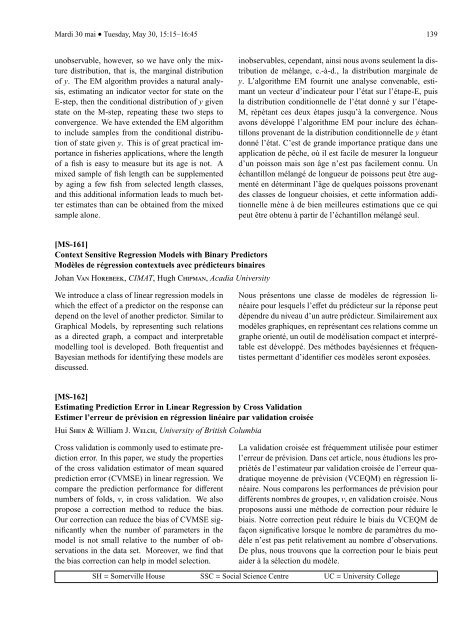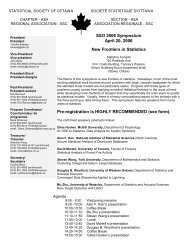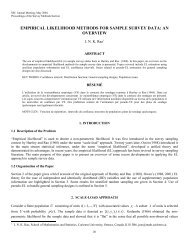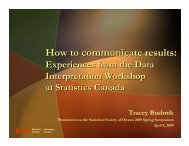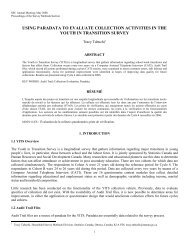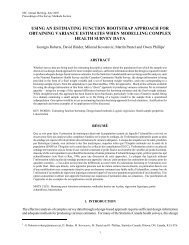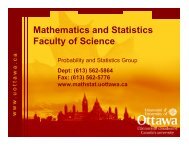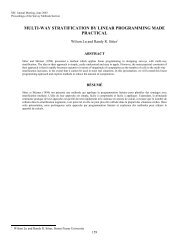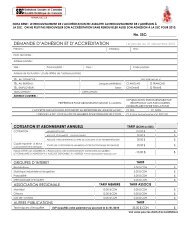Programme et résumés (pdf) - Société statistique du Canada
Programme et résumés (pdf) - Société statistique du Canada
Programme et résumés (pdf) - Société statistique du Canada
Create successful ePaper yourself
Turn your PDF publications into a flip-book with our unique Google optimized e-Paper software.
Mardi 30 mai • Tuesday, May 30, 15:15–16:45 139inobservables, cependant, ainsi nous avons seulement la dis-tribution de mélange, c.-à-d., la distribution marginale dey. L’algorithme EM fournit une analyse convenable, esti-mant un vecteur d’indicateur pour l’état sur l’étape-E, puisla distribution conditionnelle de l’état donné y sur l’étape-M, répétant ces deux étapes jusqu’à la convergence. Nousavons développé l’algorithme EM pour inclure des échan-tillons provenant de la distribution conditionnelle de y étantdonné l’état. C’est de grande importance pratique dans uneapplication de pêche, où il est facile de mesurer la longueurd’un poisson mais son âge n’est pas facilement connu. Unéchantillon mélangé de longueur de poissons peut être aug-menté en déterminant l’âge de quelques poissons provenantdes classes de longueur choisies, <strong>et</strong> c<strong>et</strong>te information addi-tionnelle mène à de bien meilleures estimations que ce quipeut être obtenu à partir de l’échantillon mélangé seul.unobservable, however, so we have only the mixturedistribution, that is, the marginal distributionof y. The EM algorithm provides a natural analysis,estimating an indicator vector for state on theE-step, then the conditional distribution of y givenstate on the M-step, repeating these two steps toconvergence. We have extended the EM algorithmto include samples from the conditional distributionof state given y. This is of great practical importancein fisheries applications, where the lengthof a fish is easy to measure but its age is not. Amixed sample of fish length can be supplementedby aging a few fish from selected length classes,and this additional information leads to much b<strong>et</strong>terestimates than can be obtained from the mixedsample alone.[MS-161]Context Sensitive Regression Models with Binary PredictorsModèles de régression contextuels avec prédicteurs binairesJohan VAN HOREBEEK, CIMAT, Hugh CHIPMAN, Acadia UniversityNous présentons une classe de modèles de régression linéairepour lesquels l’eff<strong>et</strong> <strong>du</strong> prédicteur sur la réponse peutdépendre <strong>du</strong> niveau d’un autre prédicteur. Similairement auxmodèles graphiques, en représentant ces relations comme ungraphe orienté, un outil de modélisation compact <strong>et</strong> interpré-table est développé. Des méthodes bayésiennes <strong>et</strong> fréquentistesperm<strong>et</strong>tant d’identifier ces modèles seront exposées.We intro<strong>du</strong>ce a class of linear regression models inwhich the effect of a predictor on the response candepend on the level of another predictor. Similar toGraphical Models, by representing such relationsas a directed graph, a compact and interpr<strong>et</strong>ablemodelling tool is developed. Both frequentist andBayesian m<strong>et</strong>hods for identifying these models arediscussed.[MS-162]Estimating Prediction Error in Linear Regression by Cross ValidationEstimer l’erreur de prévision en régression linéaire par validation croiséeHui SHEN & William J. WELCH, University of British ColumbiaLa validation croisée est fréquemment utilisée pour estimerl’erreur de prévision. Dans c<strong>et</strong> article, nous étudions les pro-priétés de l’estimateur par validation croisée de l’erreur qua-dratique moyenne de prévision (VCEQM) en régression li-néaire. Nous comparons les performances de prévision pourdifférents nombres de groupes, v, en validation croisée. Nousproposons aussi une méthode de correction pour ré<strong>du</strong>ire lebiais. Notre correction peut ré<strong>du</strong>ire le biais <strong>du</strong> VCEQM defaçon significative lorsque le nombre de paramètres <strong>du</strong> mo-dèle n’est pas p<strong>et</strong>it relativement au nombre d’observations.De plus, nous trouvons que la correction pour le biais peutaider à la sélection <strong>du</strong> modèle.Cross validation is commonly used to estimate predictionerror. In this paper, we study the propertiesof the cross validation estimator of mean squaredprediction error (CVMSE) in linear regression. Wecompare the prediction performance for differentnumbers of folds, v, in cross validation. We alsopropose a correction m<strong>et</strong>hod to re<strong>du</strong>ce the bias.Our correction can re<strong>du</strong>ce the bias of CVMSE significantlywhen the number of param<strong>et</strong>ers in themodel is not small relative to the number of observationsin the data s<strong>et</strong>. Moreover, we find thatthe bias correction can help in model selection.SH = Somerville House SSC = Social Science Centre UC = University College


